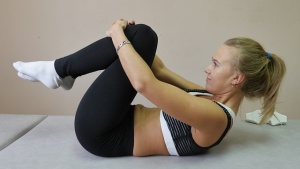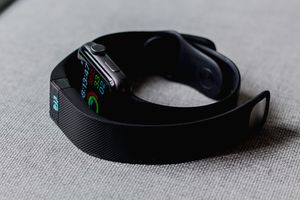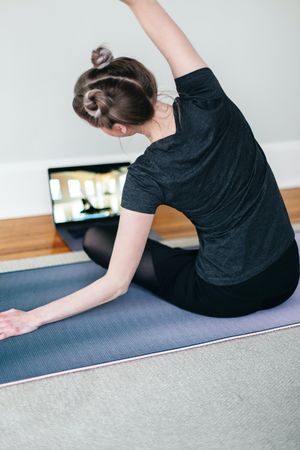Barriers to Treatment Adherence in Physiotherapy Outpatient Clinics a Systematic Review
Introduction [edit | edit source]

Adherence to home exercises (HEP) in rehabilitation is a meaning problem, and the reasons for this are multifactorial, roofing both psychological and situational factors that vary between each private, and that demand to exist considered by clinicians in the blueprint of personalized exercise programs[one].
- Providing a dwelling house exercise program (HEP) to patients is ane of the most fundamental and important aspects of physiotherapy.[2]
- Patients who adhere to their prescribed exercises are significantly ameliorate at achieving their goals and demonstrate a greater increment in physical function[3] [iv] [5].
- Patients adhere poorly to their prescribed domicile program, with varying estimations from research.[6] Not-adherence to a dwelling do plan has been shown to exist as high every bit 50-65% for general MSK conditions.[7] In the depression back pain patient population, non-adherence to home practice has been shown to exist equally high as 50-70%.[6]
- Nonadherence of a HEP increases the risk of recurrent injury or flare-ups with less positive outcomes long term[ii] and tin can event in the physiotherapist believing that their current handling is non effective.[8]
- Overall, at that place is a need for good quality evidence to identify potential barriers to patient adherence and the strategies that are effective at combating those barriers.
Factors Affecting Compliance and Performance [edit | edit source]

When setting a HEP retrieve that the long list y'all may put together may be all inclusive but research shows [9]
- Subjects who were prescribed ii exercises performed meliorate than subjects who were prescribed viii exercises, another report finding those prescribed 4 or more exercises had a lower charge per unit of compliance than those prescribed ii or fewer[ten]
- Subjects who are prescribed 2 exercises will perform better than subjects who are prescribed 8 exercises
- Subjects who are prescribed 2 exercises will comply on their self-report exercise log more than subjects who are prescribed 8 exercises
- Compliance with behavioral treatments (eg, an exercise program) is similar to drug compliance; every bit complexity increases, compliance decrease (confused man R).
Factors Affecting Adherence [edit | edit source]
-
Perceived Barriers - eg forgetting to do, not having the time, not fitting into the daily routine, work schedules[1](See image, busy multi tasking at habitation).
- Cocky-Efficacy ie an individual's belief in their ain adequacy to achieve a task that will produce a targeted result.
- Threat and Beliefs ie The behavior a patient holds regarding their condition and the decisions made by patients are based on their ain beliefs, personal experiences, and the information they receive.
- Locus of Control - patients with an external locus of control demonstrate a lesser caste of adherence with HEP.
- Pain - Pain levels during do in musculoskeletal patients presented strong evidence as a barrier to adherence in a systematic review.[1]
- Physical Activity - Studies suggest that those who are physically agile at baseline demonstrate significantly better adherence to home do programs.
- Psychological Symptoms - Depression as a barrier to adherence has strong supporting evidence.[one]
- Social Support - The social support network of the patient has also been suggested as a possible factor in adherence eg friends and family members, every bit well equally support from the therapist.
This is a good video (10 minutes) on barriers to practice, or perceived barriers, to exercise and ways to overcome them.
Health Technologies [edit | edit source]
Wellness technologies, such equally the employ of mobile devices, including mobile phones and tablets, every bit well as software apps, provide u.s.a. with the opportunity to better support the patient and clinician, with a data-driven arroyo that incorporates features designed to increase adherence to exercise such as coaching, self-monitoring and education, every bit well as remotely monitor adherence rates more objectively.

Software apps be on the market and may well change the fashion of many home exercise plans in clinics. The promise to do such things as " make it like shooting fish in a barrel to build a abode practice program in seconds, with beautifully designed instructional videos. The congenital-in efficiencies will reduce your workload. Plus, our software motivates your patients and improves outcomes, with tracking tools and insightful analytics." Research is yet to confirm this merely many clients like the idea of visualisation and direct feedback[12]
Combining the popularity of mobile devices with the on-going search for fitness, thousands of fitness applications (apps) are available for free or low cost. Apps let users to set fettle goals, track action, gather workout ideas, and share progress on social media. Physiotherapists should stay abreast with recent research and follow the guideline equally they emerge.
- Those who utilized the apps were more likely to accept a positive mental attitude about the apps.
- Usefulness and perceived difficulties in particular should be considered with hereafter app development.
- App usefulness and ease of utilize may be facilitated past using wellness behavior theories to guide development.[13]
- Ane systematic review identified strong evidence for computerized applied science not being more than constructive at improving HEP adherence compared to other strategies. [14]
Strategies to Increase Adherence [edit | edit source]

Patient Instruction [edit | edit source]
- Educating patients on pain versus impairment past explaining the nature of pain and nociception and suspending the belief that pain is an indicator of further tissue damage [ii]
- Reinforcing messages which reduce fearfulness or feet about hurting [ii]
- Emphasizing the thought that exercise will lead to less pain, anxiety, and depression
- Countering maladaptive coping strategies [xiv]
- Employing motivational techniques [15] and Motivational interviewing to set personal treatment goals [2]
- Managing expectations by educating patients the importance of their ain HEP.
Treatment [edit | edit source]
- Minimizing pain during a HEP eg heat, ice or TENS pre or post session. [2]
- Utilize a graduated HEP - to reduce feet and fear avoidance, progress slowly and gradually to increase patients' confidence in their own concrete abilities [2]
- Providing clear HEP, both printed and exact instructions, when introducing a new exercise program, check patient's power to recall.[ii]
- Encouraging patients to keep exercise logs, diaries, logs to track their progress, symptoms, etc [14]
- Reviewing exercise and symptom logs at every treatment [14]
Personalized Approach [edit | edit source]
- Tailoring exercise plan demands to the patient. Patients should exist introduced to regular practice in pocket-size steps that they feel confident they tin manage [2]
- Participating in Telerehabilitation and Smartphone Apps in Physiotherapy in the course of email support or phone support [fourteen]
- Providing patients with pictures and videos of themselves performing the prescribed exercises [14]
- Establishing a personalized HEP negotiated and agreed upon with the patient [15]
- Include social network, for encouragement and involvement, and to boost their confidence [2]
These videos beneath (total 6 minutes) requite insight to HEP and adherence.
| [xvi] | [17] |
Measurements of Adherence [edit | edit source]
- Diaries. Limitations - poor completion rates, inaccurate recall and self-presentation bias. [6]
- Computer programs, phone applications and wearable technology (east.g. pedometers) [half-dozen]
- See also Physical Action and Outcome Measure
The post-obit are samples of tools available to estimate patient adherence [18]
- Sports Injury Rehabilitation Adherence Scale (SIRAS)- iii-item calibration completed by the therapist
- Hopkins Rehabilitation Engagement Rating Scale (HREPS)- 5-item questionnaire completed by the health professional in an acute inpatient setting.
- Adherence to Exercise Scale for Older Patients (AESOP)- patient completed 43-detail questionnaire
- The Modified Rehabilitation Adherence Questionnaire (RAQ-M)- 25-item calibration to evaluate potential barriers to patient adherence
Barriers to Adherence [edit | edit source]
Level of Bear witness
- Strong
- Hurting - worsening hurting during a treatment session is associated with a barrier to a home exercise program [ii]
- Low levels of physical action at baseline - patients who are not used to following a regular fitness program are less likely to incorporate a physiotherapy exercise program into their schedule [2]
- Depression self-efficacy
- Anxiety or stress at baseline - strong predictor of poorer outcomes at long term follow-ups [ii]
- Depression - lower levels of depression are correlated to a greater motivation to exercising [2]
- High degree of helplessness
- Lack of social back up - the absence of a strong back up network can atomic number 82 to lower levels of adherence to a HEP [2]
- Perceiving barriers to exercise eg transportation bug, child care needs, work schedules, lack of time, family dependents, financial constraints, convenience and forgetting [2]
- High levels of neuroticism [8]
two. Moderate
- Internal locus of control the conventionalities that individuals are responsible for their own outcomes (attach improve to domicile exercise programs) [8]
three. Express Level of Evidence
- Higher inability level - those with higher disability level were more than likely to attach to a HEP [vi]
- Lower motivation - research shows no clear relationship between motivation level and adherence to HEP [half-dozen]
4. Conflicting Evidence
- Greater pain at baseline - unclear whether greater pain at baseline serves as a motivating factor or a barrier to exercise adherence [2]
- Historic period - currently there is evidence on whether older patients vs younger clients attach more or less to their HEP [2]
- Low levels of optimism - although low levels of optimism are associated with withdrawal from goal pursuits there is no articulate evidence that information technology results in decreased adherence [viii]
Resources [edit | edit source]
This article by Bollen et al (2014) cites 58 studies reporting on 61 measures of cocky-reported adherence, thus the measures can exist adamant through using the reference list.
References [edit | edit source]
- ↑ 1.0 i.i 1.2 1.3 Argent R, Daly A, Caulfield B. Patient interest with home-based exercise programs: can connected health interventions influence adherence?. JMIR mHealth and uHealth. 2018;vi(three):e47.Available from: https://world wide web.ncbi.nlm.nih.gov/pmc/articles/PMC5856927/ (terminal accessed 19.v.2020)
- ↑ 2.00 two.01 2.02 2.03 2.04 2.05 two.06 ii.07 two.08 ii.09 two.10 2.11 2.12 2.13 2.14 2.15 2.xvi 2.17 Jack K, McLean SM, Moffett JK, Gardiner East. Barriers to treatment adherence in physiotherapy outpatient clinics: A systematic review. Manual Therapy, 2010, 15: 220–228
- ↑ Di Fabio RP, Mackey G, Holte JB. Disability and functional status in patients with low back hurting receiving workers' bounty: a descriptive study with implications for the efficacy of physical therapy. Physical Therapy. 1995 Mar 1;75(iii):180-93.
- ↑ Pinto BM, Rabin C, Dunsiger Due south. Home‐based do amidst cancer survivors: adherence and its predictors. Psycho‐Oncology: Journal of the Psychological, Social and Behavioral Dimensions of Cancer. 2009 Apr;18(iv):369-76
- ↑ Karnad P, McLean S. Physiotherapists' perceptions of patient adherence to home exercises in chronic musculoskeletal rehabilitation. International Periodical of Physiotherapy. 2011 Jun;1(two):xiv-29
- ↑ 6.0 half-dozen.1 6.2 6.3 6.4 vi.v Beinart NA, Goodchild CE, Weinman JA, Ayis S, Godfrey EL. Private and intervention-related factors associated with adherence to abode exercise in chronic low back pain: a systematic review. The Spine Journal, 2013, thirteen:1940–195
- ↑ Bassett SF. The assessment of patient adherence to physiotherapy rehabilitation. NZ J Physiother, 2003, 31: lx–66
- ↑ eight.0 viii.1 8.two viii.three Wright BJ, Galtieri NJ, Fell K. Non-adherence to prescribed home rehabilitation exercises for musculoskeletal injuries: the function of the patient- practitioner relationship. J Rehabil Med, 2014, 46: 153–158
- ↑ Henry KD, Rosemond C, Eckert LB. Effect of number of home exercises on compliance and performance in adults over 65 years of age. Physical Therapy. 1999 Mar i;79(3):270-vii. Available from:https://academic.oup.com/ptj/article/79/three/270/2837047 (last accessed 19.v.2020)
- ↑ Eckard T, Lopez J, Kaus A, Aden J. Home exercise plan compliance of service members in the deployed environment: an observational accomplice study. Military medicine. 2015 Feb i;180(2):186-91. Bachelor from: https://world wide web.ncbi.nlm.nih.gov/pubmed/25643386 (last accessed nineteen.5.2020)
- ↑ Miss Massey. Barriers To Exercise Adherence. Bachelor from: http://www.youtube.com/spotter?five=PeqaRuDS0ko [last accessed xxx/08/2016]
- ↑ Physioted Physiotherapy exercise app Available from:https://physiotec.ca/au/en/?gclid=CjwKCAjwwYP2BRBGEiwAkoBpAqyXxFghVKgKZXYdlWmnRBwSHtVcXJe8qV_6GI0DnAyGEZtO7EJYiBoCvVIQAvD_BwE (concluding accessed eighteen.five.2020)
- ↑ Herrmann LK, Kim J. The fitness of apps: a theory-based examination of mobile fettle app usage over v months. Mhealth. 2017;3. Available from:https://www.ncbi.nlm.nih.gov/pmc/manufactures/PMC5344171/ (last accessed xviii.five.2020)
- ↑ 14.0 fourteen.1 14.2 14.iii fourteen.4 14.v Gaikwada SB, Mukherjee T, Shahb PV, Ambodeb OI, Johnson EG, Dahera NS. Home exercise program adherence strategies in vestibular rehabilitation: a systematic review. Phys Ther Rehabil Sci, 2016, v(2), 53-62
- ↑ 15.0 15.i McLean SM, Burton M, Bradley L, Littlewood C. Interventions for enhancing adherence with physiotherapy: A systematic review. Transmission Therapy, 2010 fifteen: 514-521
- ↑ TED Talks. Cosmin Mihaiu: Physical therapy is boring — play a game instead. Bachelor from: http://www.youtube.com/watch?five=3_AZ5R2SC88 [last accessed thirty/08/2016]
- ↑ ELLICSR: Wellness, Health and Cancer Survivorship Heart. Dr. Paul Ritvo on How Cancer Survivors Adhere to an Exercise Programme and Why: Nosotros-Can Programme. Available from: http://www.youtube.com/lookout?v=ib-nL77WYTs [last accessed 30/08/2016]
- ↑ McLean S, Holden G, Haywood Thousand, Potia T, Gee Thou, Mallett R, Bhanbhro Southward. Recommendations for exercise adherence measures in musculoskeletal settings: a systematic review and consensus meeting. Projection Report. Chartered Order of Physiotherapy. 2014. (Submitted)
villanuevafrompeat1957.blogspot.com
Source: https://www.physio-pedia.com/index.php?title=Adherence_to_Home_Exercise_Programs&veaction=edit§ion=8
0 Response to "Barriers to Treatment Adherence in Physiotherapy Outpatient Clinics a Systematic Review"
Postar um comentário